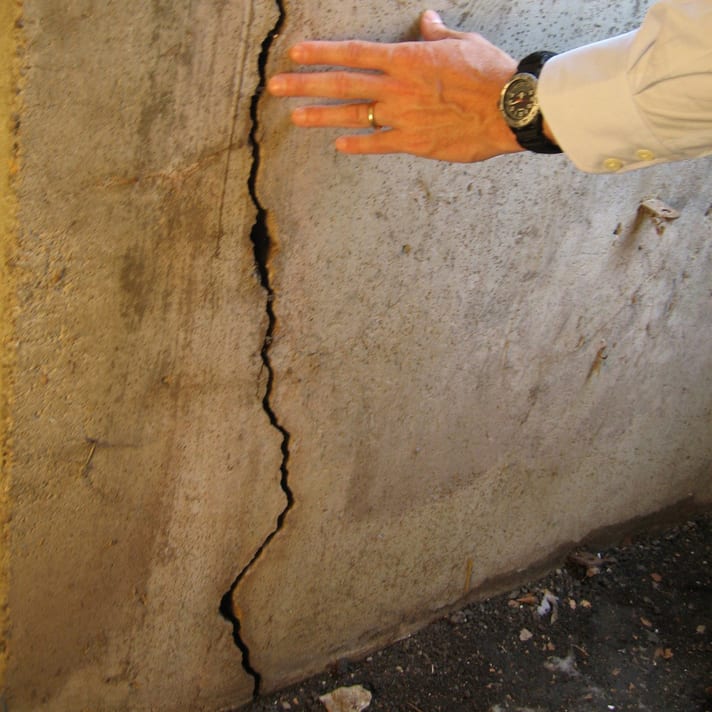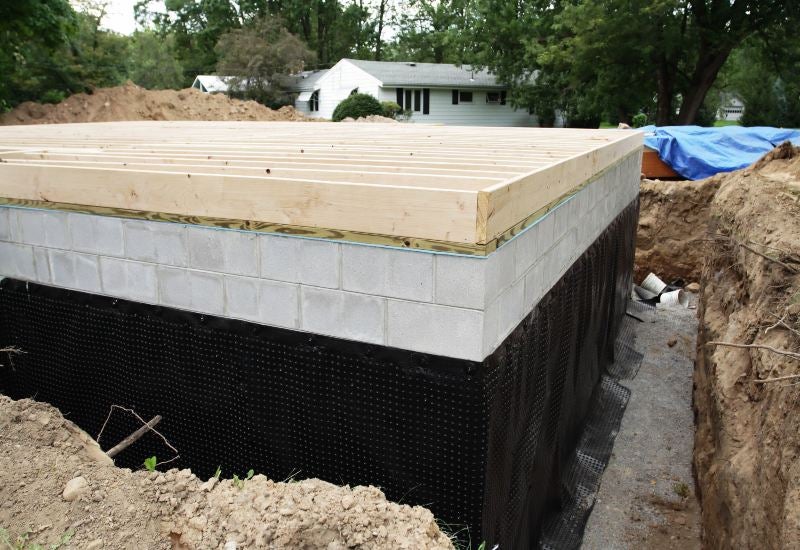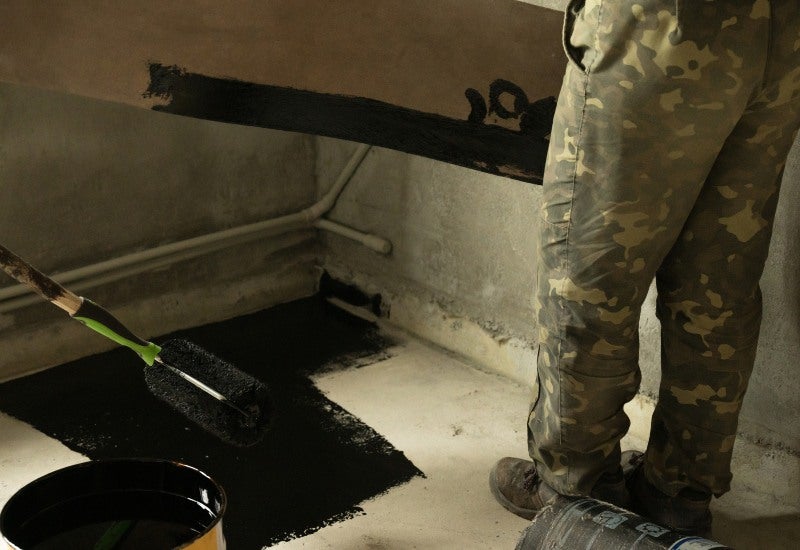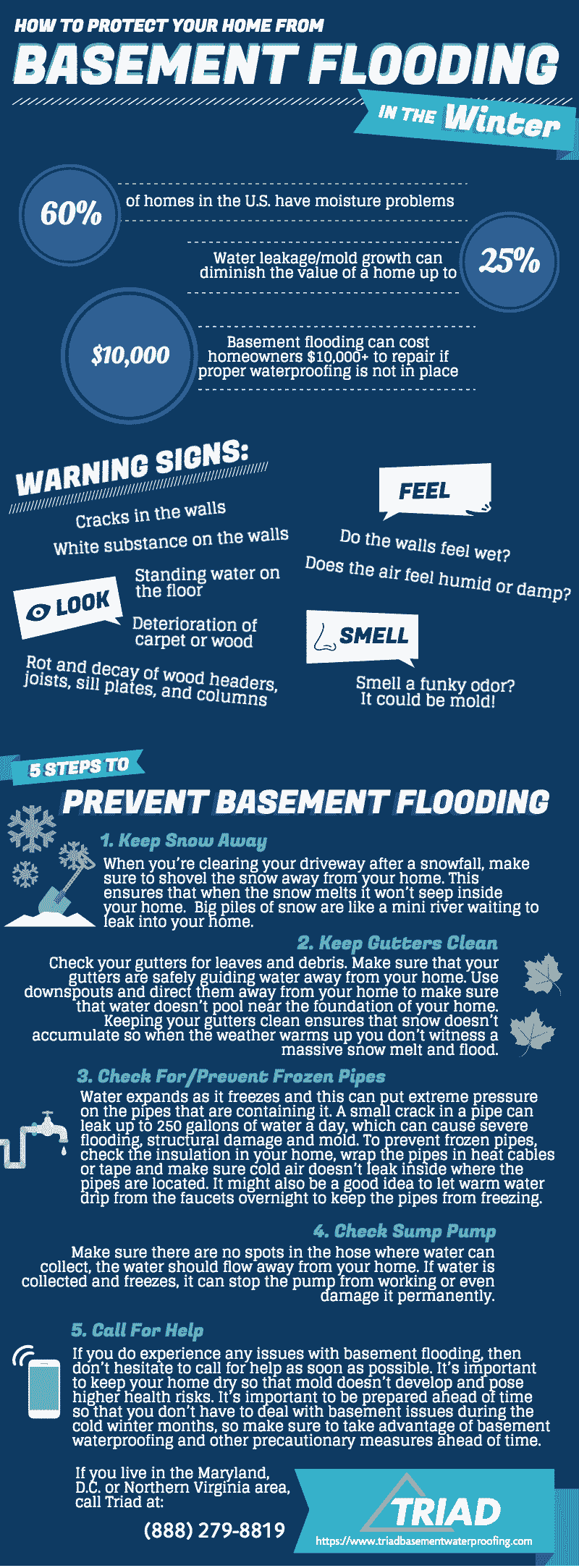-
What Causes Concrete Foundation Cracks?
What Causes Concrete Foundation Cracks?
Although our homes are built to be resilient to many things, after some time they tend to wear down. In the same way we show signs of age through wrinkles, our homes show it through imperfections and cracks. With the flaws of imperfect construction, pressure surrounding the home and the weight of the house bearing down on it, the foundation of your home takes it all. When it comes to foundation cracks or repairs, the important thing is to take care of the issue as soon as possible. It’s not a good idea to forget about it and wait until the crack gets bigger and allows water to leak into your basement and flood your home.
All concrete has the tendency to crack and there is no way to produce crack-free concrete. Concrete expands and shrinks with changes in temperature and moisture and this can cause cracking early on. Often concrete foundation cracks are not detected until long after they’ve formed. Regardless of how long the crack has been there, it tends to concern homeowners and they worry about the imperfection.
Cracks in concrete foundation most often appear at weak points like corners, basement window frames, walls and pipe areas. It’s important to keep track of these cracks and notice if they are getting bigger. It’s also important to understand why the crack showed up in the first place. What causes concrete foundation cracks? Read on to find out!

Top Causes of Concrete Foundation Cracks
Drought or too much moisture
Soil shrinks like a sponge when moisture is removed from it and when that happens it pulls away from the foundation of your home creating a gap. This gap allows for the foundation to move. When the foundation of a home is not supported properly it can shift around and cracks will begin to appear. In turn, if there is too much moisture it will cause the soil that is supporting the foundation of your home to expand.
Earthquakes
When an earthquake occurs it causes the ground to shake, which in turn shakes your home around. Thankfully not too many earthquakes occur on this side of the U.S., however even the tiniest of quivers can be an issue. Remember, if the foundation isn’t supported or stable, it can move around, weaken and crack. A small earthquake may not cause new cracks, but it can intensify ones that are already present.
Storms
Whether you experience a hurricane, a nor’easter or just a typical rainstorm these storms produce a lot of water, which can damage the foundation of your home. Too much water will force the soil around the foundation of your home to expand, which will push up against the home and cause concrete foundation cracks. Storms can also cause various other structural problems if you don’t take preventive measures to secure your home. One of the most popular explanations behind concrete foundation cracks is the freeze and thaw cycle during the winter. Concrete freezes at around 18 degrees and then it melts at around 35 degrees, which is when the cracking develops.
Plumbing Leaks
It’s important to make sure your pipes are secured and aren’t leaking and that you don’t have any plumbing leaks in your home. If you’re home isn’t equipped with basement waterproofing or a sump pump, the excess water will add to the soil causing it to expand and push against your foundation.
Flooding
Regardless of whether the flooding comes from a storm, a leak, inadequate drainage or something else, too much water will be a problem for your concrete foundation. When hydrostatic pressure becomes too much for the foundation of your home you will notice more leaks, more cracks and more problems.
Extreme Heat
Concrete can also crack under extreme sun and heat because it causes the concrete to expand. During the day and under the sun the concrete will expand, and then overnight the concrete will shrink and retreat back to its original unbaked position.
Get Help Fixing Your Cracks
The moral of the story is that it is important to keep your foundation stable, dry and supported.
When your foundation has wiggle room due to dry soil or if it’s tightly pushed in by expanding soil, these movements cause it to weaken and in turn create concrete foundation cracks. The good news is that concrete foundation cracks that are a result of too much moisture and flooding can be prevented through various methods of basement waterproofing.
It’s also not too difficult to repair concrete foundation cracks with epoxy injections. If you are thinking about preventive measures or you need concrete repair, then contact the team at Triad Basement Waterproofing and they will create a custom solution to your specific situation.
-
Top 3 Methods of Basement Waterproofing
Top 3 Methods of Basement Waterproofing
A dry basement is not only essential for the structural integrity of your home, but also for maintaining a healthy living environment. Basement waterproofing is a key step in protecting your property from moisture related issues. Triad Basement Waterproofing offers comprehensive solutions to keep your basement dry and safe.

Causes of Moisture in the Basement
Before discussing the methods of basement waterproofing, it’s important to understand the common causes of basement moisture. Water can infiltrate your basement through various means, including:
- Groundwater Seepage – Water from the surrounding soil can seep through the basement walls and floor due to hydrostatic pressure. This pressure builds up when the soil around your home becomes saturated, pushing water through any available gaps or cracks.
- Surface Water Infiltration – Improperly graded landscapes can cause rainwater or melting snow to flow toward your foundation, leading to leaks. This often occurs when the ground slopes toward the house instead of away from it, allowing water to pool around the foundation.
- Plumbing Leaks – Faulty plumbing systems can introduce unwanted moisture into your basement. Leaky pipes, water heaters, or fixtures can cause continuous moisture problems if not addressed promptly.
- Condensation – High humidity levels in the basement can result in condensation, creating damp conditions. This often happens in basements with poor ventilation, where warm, moist air meets cooler surfaces.
Understanding these causes helps in choosing the right waterproofing method tailored to your specific needs.
Basement Waterproofing Methods
There are several effective methods to waterproof your basement, each catering to different causes and severities of moisture problems. Here are the top 3 methods:
-
Interior Basement Waterproofing
Interior basement waterproofing focuses on managing water that enters your basement. This method typically involves installing a drainage system that directs water to a sump pump, which then expels the water out of your basement. Key components of interior waterproofing include:
- French Drains – These are perforated pipes installed along the perimeter of the basement floor, channeling water to the sump pump.
- Sump Pumps – These devices are essential for pumping out the collected water to keep your basement dry.
- Vapor Barriers – These barriers are installed on basement walls to prevent moisture from seeping through.
-
Exterior Basement Waterproofing
Exterior basement waterproofing addresses water issues from the outside before they can penetrate the basement walls. This method is considered highly effective as it prevents water from entering your home altogether. Key components of exterior waterproofing include:
- Excavation – This process involves digging around the foundation to apply waterproofing materials directly to the exterior walls.
- Membranes – Waterproof membranes are applied to the foundation walls to create a water-resistant barrier.
- Drainage Systems – Installing exterior drainage systems, such as footing drains, helps divert water away from the foundation.
-
Interior Sealants
Interior sealants are used to seal cracks and gaps in basement walls and floors to prevent moisture ingress. This method is suitable for minor leaks and can be a quick and cost-effective solution. Key components of interior sealants include:
- Epoxy Injections – These are used to fill cracks in the walls, providing a strong and durable seal.
- Silicone-Based Sealants – These sealants are applied to joints and gaps to block moisture entry.

Advantages of Basement Waterproofing
Basement waterproofing offers numerous benefits that go beyond just keeping your basement dry:
-
-
- Enhanced Structural Integrity –Waterproofing helps prevent water damage that could weaken the foundation and structure of your home. By stopping water infiltration, you reduce the risk of foundation cracks and shifting.
- Improved Air Quality – By keeping moisture out, waterproofing reduces the risk of mold and mildew growth, promoting healthier indoor air quality. This is especially important for families with allergies or respiratory issues.
- Increased Property Value – A dry, well-maintained basement can add to the overall value of your home. Potential buyers often view a waterproof basement as a sign of proper home maintenance and care.
- Additional Living Space—Waterproofing allows you to utilize your basement as a functional and comfortable living area. Whether you want to create a home gym, office, or an additional bedroom, a dry basement provides the perfect foundation for your plans.
-
By understanding the causes of basement moisture and implementing the right waterproofing methods, you can safeguard your home effectively. Triad Basement Waterproofing is here to help you every step of the way, offering professional solutions tailored to your specific requirements. Protect your home today and enjoy a dry, safe basement for years to come.
Choose Triad Basement Waterproofing in Gaithersburg, MD
Triad Basement Waterproofing in Gaithersburg, MD, is your trusted partner in basement waterproofing solutions. With years of experience and a commitment to quality, our team provides reliable services to protect your home from moisture-related issues. We offer a comprehensive range of services, from interior and exterior waterproofing to expert advice on maintaining a dry basement.
Contact us today to schedule a consultation and learn more about how we can help keep your basement dry and secure. Visit our website at Triad Basement Waterproofing to explore our services and discover why homeowners in Gaithersburg trust us for their waterproofing needs.
-
How to Prevent a Flooded Basement in the Winter
How to Prevent a Flooded Basement in the Winter
Winter is upon us and that means that it is very important to protect our basements from any flooding this year. Heavy snow, heavy rain and in turn heavy snowmelts are extremely threatening to unprotected basements. Many people believe that the rainy season is the worst time of year for a basement. While heavy rain does pose a high threat to unprotected basements, winter and snow can be worse.
When the temperature of the ground is above freezing the accumulated snow instantly melts and turns into water, which has the same effect as rain. If the temperature of the ground is below freezing, snow will accumulate and as soon as the temperature rises it can turn into a heavy stream of water pounding against the foundation of your home. When water accumulates around your home, the water can seep through any porous surfaces, cracks in the foundation, window wells, etc.
You know how a quick change in temperature from cold to hot can crack glass?
Big temperature changes can do the same thing to your foundation, weakening it over time and allowing water to flow freely into your basement. The last thing you want to do is walk into a flooded basement during the cold winter months! Don’t wait till winter to invest in basement waterproofing, the colder weather makes it tough to work outside, so it is important to take care of the work before the temperatures drop.
Here are some tips from the professionals at Triad Basement Waterproofing that will show you how to prevent a flooded basement in the winter.

- Keep Snow Away From Your Home
When you’re clearing your driveway after a snowfall, make sure to shovel the snow away from your home. This ensures that when the snow melts it won’t seep inside your home. Big piles of snow are like a mini river waiting to leak into your home.
- Keep Your Gutters Clean
Keeping your gutters clean is something you should be doing throughout the year anyway. Before winter comes around check your gutters for leaves and debris. Make sure that your gutters are safely guiding water away from your home. Use downspouts and direct them away from your home to make sure that water doesn’t pool near the foundation of your home. Keeping your gutters clean ensures that snow doesn’t accumulate so when the weather warms up you don’t witness a massive snow melt and flood.
- Check for & Prevent Frozen Pipes
Water expands as it freezes and this can put extreme pressure on the pipes that are containing it. Pipes that freeze often are those that are exposed to severe cold such as swimming pool supply lines, sprinklers, outdoor faucets and other pipes housed in unheated areas like the basement, garage or attic. A small crack in a pipe can leak up to 250 gallons of water a day, which can cause severe flooding, structural damage and mold. To prevent frozen pipes you can check the insulation in your home, wrap the pipes in heat cables or tape and make sure cold air doesn’t leak inside where the pipes are located. It might also be a good idea to let warm water drip from the faucets overnight to keep the pipes from freezing.
- Check Your Sump Pump
Double check your sump pump before winter rolls around. Make sure there are no spots in the hose where water can collect, the water should flow away from your home. If water is collected and freezes, it can stop the pump from working or even damage it permanently.
- Call for Help!
If you do experience any issues with basement flooding, then don’t hesitate to call for help as soon as possible. It’s important to keep your home dry so that mold doesn’t develop and pose higher health risks. It’s important to be prepared ahead of time so that you don’t have to deal with basement issues during the cold winter months, so make sure to take advantage of basement waterproofing and other precautionary measures ahead of time.
Coming home to find your basement flooded is never fun, but experiencing flooding during the cold winter months can be brutal. The winter season is supposed to be warm and cozy and there’s nothing like a flooded basement to ruin the whole experience for you and your family. It’s important to know what to look for and how to prevent a flooded basement in the winter. Triad Basement Waterproofing has more than 27 years of experience dealing with basement water problems and the experts here can help insure that your home stays dry at any given time of the year. Check out our website for a full list of services and contact us if you have any questions !
